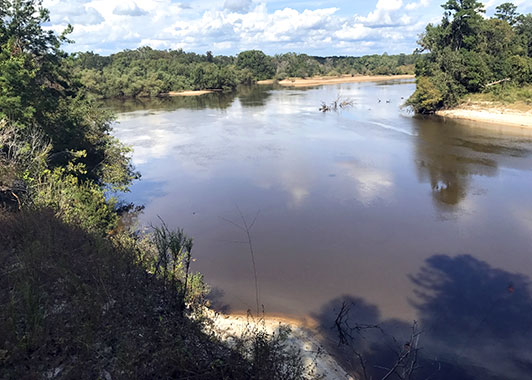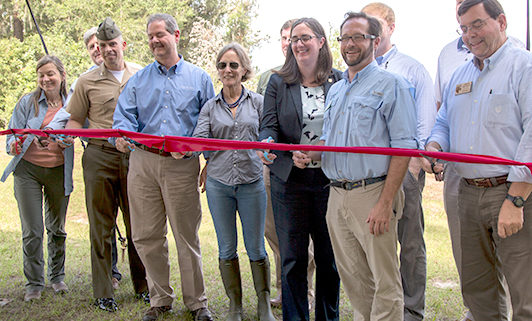Sansavilla Conserved!
Protection of the lower Altamaha River began in 1968, piece by piece. The pace accelerated in the last twelve years as federal and state agencies collaborated with non-profits and private philanthropy, investing more than $90 million to underwrite conservation easements and outright purchases. The “missing piece,” a 19,500 acre property known as Sansavilla featuring 12 miles of Altamaha River frontage, is finally secure. A host of partners made it possible using a phased approach: The Conservation Fund, The Nature Conservancy of Georgia, Georgia Department of Natural Resources, U.S. Fish & Wildlife Service, U.S. Forest Service, and the Department of Defense. Private philanthropy played a critical role with leadership from the Robert W. Woodruff Foundation and the Knobloch Family Foundation. A ribbon cutting was held on October 16 to mark the closing of the final phase.
First as a footpath and then as a ferry landing, for centuries Sansavilla Bluff has been a waypoint for people crossing the immense Altamaha River floodplain. Now the Bluff serves as the linchpin in a decades-long effort to safeguard and restore the lower Altamaha.
 At Sansavilla, slash and loblolly “pines in lines” are being cut or thinned to restore the once-dominant longleaf pine forest and its understory plants. With prescribed burns every few years to control competing vegetation, the rich plant diversity will support greater numbers of a wide variety of wildlife, including the gopher tortoise.
At Sansavilla, slash and loblolly “pines in lines” are being cut or thinned to restore the once-dominant longleaf pine forest and its understory plants. With prescribed burns every few years to control competing vegetation, the rich plant diversity will support greater numbers of a wide variety of wildlife, including the gopher tortoise.
As a keystone species — one whose presence in the landscape enables other plants and animals to thrive — tortoises excavating burrows for their own living quarters draw as many as 350 species of animal “tenants,” from tiny mites to indigo snakes and burrowing owls. As testimony that Sansavilla is prime tortoise habitat, 400 tortoises already make their home there. Now the tract also will serve as a refuge for tortoises relocated from construction and mining sites elsewhere within their range. Ultimately, conservation biologists expect up to 1000 residents when restoration is complete.
While few of us will live to see the longleaf seedlings at Sansavilla Bluff reach their old-growth majesty, conservation success stories are happening right before our eyes along the Altamaha. A unique collaboration focused on conserving and restoring this historic landscape will benefit generations of Georgians yet to come.
For more information about the Gopher Tortoise Initiative and the crucial role tortoises play in the native longleaf pine and sandhill ecosystems, please see “The Gopher Tortoise: A Catalyst for Conservation,” in the previous issue of Shoreline.
Ribbon cutting photo by Lance Cpl. Moreno; Sansavilla Bluff photo by Scott Coleman.





